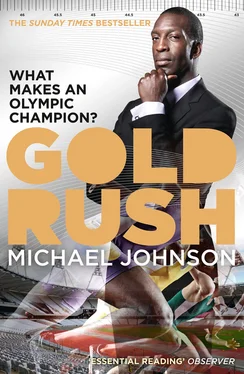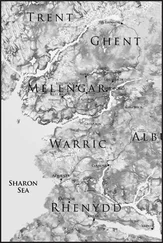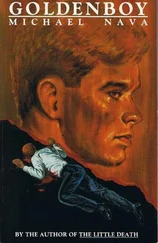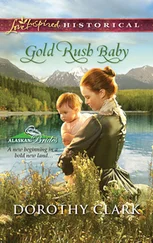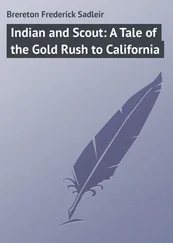This was the first time I started to have to think about how I was going to beat other athletes. How was I going to run faster than them? I had to learn to prepare to compete against them. If a racer was in front of me and I had to go get him, what should I do? Did I just try harder? Did I need to be patient?
You need to think about those things before the race starts. In addition, because you know the athletes you’re up against, you know what they’re capable of, it makes you nervous. How do you deal with that? And how do you deal with the expectations and the pressure and still deliver your best performance? When you put all of that together, what you’re doing is learning to compete.
I would have to wait a few years for that. By the time I was 13 I was already faster than everyone on my school track team, but in competitions against other schools I would win some races and lose some races. I won more than I lost, but when I lost I was disappointed because I didn’t like the feeling of losing any more as a young teenager than I had as a youth. I don’t know what it was that I didn’t like about losing other than the fact that if I was losing, then I wasn’t winning, and I liked winning.
At that point in my life I didn’t know what to do about losing except to work harder at whatever drill my coach was giving me during practice each day, and to try harder in the races. This seemed to help somewhat but still didn’t guarantee me victory every time.
What I know now, as an owner of a performance training company training youth athletes between the ages of 9 and 18, is that it’s between 12 and 15 that most kids will make a major leap in their natural athletic ability. Some will develop faster than others. I remember that one of the kids I beat the first time I raced him proceeded to beat me every other time we raced. I don’t know what his real name was, but he went by the name Tank. As his name might indicate, he was bigger than me. I remember that he had very thick legs and already had a moustache. Knowing what I know now, I would say that Tank was probably a bit ahead of me in his development.
I took two years away from sport from the age of 14 when I first started high school. My school was a special career development school that only accepted the best of the kids who applied, and each student chose a career focus from many different offerings. At the time I dreamed of becoming an architect, so I spent half of the day learning about that particular career. Eventually I missed sport and came back to track.
When I started competing again at the age of 16, having not played any sports for two years, I had made a big leap in my athletics development, in large measure because I had matured physically. I was immediately winning races easily and working hard which had become standard procedure for me. But I still wasn’t winning every race and I still hated that. In my third year of high school I had won every race until the district championship which I lost, finishing third, and it ended my season. Roy Martin and Gary Henry, who were older than me by one year and in their final years of high school and also very good athletes, had both finished ahead of me.
GOOD COACHING HELPS
The more I thought about why I had lost, the more I put together different things I had heard from other people about the impact that good track coaches who trained their athletes all year could make. My coach, Joel Ezar, was a wonderful man with whom I had a great relationship. But he was not a great track coach; he was a football coach who coached track in the spring when the football season was over. So I simply wasn’t as ready as those other athletes I was losing to. In addition, they knew more about what they were doing on the track than I did.
I didn’t know what to do about the coaching gap, but believed that I could solve it by working harder. The next year, my final year of high school, two other athletes/friends and I began to go out on our own after school and run. We didn’t really know what we were doing but we didn’t know that. We just felt that if we worked in the autumn instead of doing nothing we would be better in the spring.
I hadn’t yet developed my absolute hatred for losing (rather than mere dislike of it). Even so, I was always looking for a way to prevent myself from losing. Throughout my life, as I matured and moved from one level of training and competing to the next, it became clearer exactly what I needed to do to be the best I could be. I just always believed that if I was the best I could be, I wouldn’t lose.
I’ve always said, and I always tell athletes, that if you run your best race and you lose, you have nothing to be ashamed of or disappointed in. I still believe that. But I, personally, never had a loss where I felt it was my best race. Even when I competed to my best ability in high school and lost, I didn’t feel it was my best race because I didn’t feel I was as prepared from a training standpoint as I could have been. A big part of my decision when I was deciding which university to compete for was which coach would be able to help me achieve my best.
In spite of not having a real track coach during my high school career, I still managed to win both the district and regional championships. At the state championship I finished second in the 200 metres behind Derrick Florence, who still holds the high school record for 100 metres and to whom I would never lose again. I wasn’t happy about not winning, but I was more excited that I would be competing at college than I was disappointed that I had lost the state championship.
Originally I viewed the track scholarship I’d accepted from Baylor University only as a means to go to a better college than I would if I had to pay for it myself. But in 1986, between high school and college, I finally start thinking about professional track. I was working in an office that summer, when I started seeing newspaper headlines about the US Olympic Sports Festival in Houston. Reading about Carl Lewis, Calvin Smith and Floyd Heard arriving in Houston to compete in this high-level competition triggered my initial aspirations to run and compete professionally. After finishing the article I found myself for the first time daydreaming about competing against the best in the world and envisioning myself being at this competition with these athletes. I started to really believe that I could be great, because I knew that I hadn’t reached my full potential in high school.
At Baylor University I was in a serious training programme for the first time. It was tough in the beginning. I hated the weight workouts, which I avoided. But I loved training on the track each day and looked forward to it. I approached each day like a competition because I could feel myself getting stronger and better.
AIMING HIGH, HIGHER, HIGHEST
Even though I made some great strides during my first year, I got injured at the end of the season and wasn’t able to compete in the NCAA (National Collegiate Athletic Association) university championships. So the following year I focused on becoming an NCAA champion. I hadn’t even considered higher-level competition – let alone the Olympics – until one of my team-mates, Raymond Pierre, went on to compete in the US national championships after the college national championships. Raymond did really well at the US championships, finishing fourth in the 400 metres. This earned him a position on the US national team for the 1987 World Championships, which would be held later in the summer in Rome. Raymond spent most of the summer in Europe competing on the international circuit and once competed as an alternate for the US team, running in the preliminary round of the 4 x 400 metres relay team that won the gold medal.
The day he returned from Rome, school had already started and the team had already started training. Raymond came out to the track wearing a USA team uniform shirt. The only way to get your hands on any official USA track team gear was to make a US team, which was a great accomplishment, so having the gear was a badge of honour. I had seen in my freshman year a handful of athletes from other universities who had competed on US teams wearing USA team gear, and I wanted that. It seemed really cool, because it showed the accomplishment, and signified how good the athlete was.
Читать дальше
